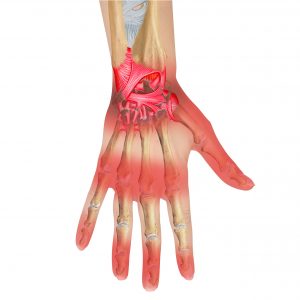Abstract
Background
People with carpal tunnel syndrome (CTS) exhibit widespread pressure pain and thermal pain hypersensitivity as a manifestation of central sensitization. The aim of our study was to compare the effectiveness of manual therapy versus surgery for improving pain and nociceptive gain processing in people with CTS.
Methods
The trial was conducted at a local regional Hospital in Madrid, Spain from August 2014 to February 2015. In this randomized parallel-group, blinded, clinical trial, 100 women with CTS were randomly allocated to either manual therapy (n = 50), who received three sessions (once/week) of manual therapies including desensitization manoeuvres of the central nervous system, or surgical intervention (n = 50) group. Outcomes including pressure pain thresholds (PPT), thermal pain thresholds (HPT or CPT), and pain intensity which were assessed at baseline, and 3, 6, 9 and 12 months after the intervention by an assessor unaware of group assignment. Analysis was by intention to treat with mixed ANCOVAs adjusted for baseline scores.
Results
At 12 months, 95 women completed the follow-up. Patients receiving manual therapy exhibited higher increases in PPT over the carpal tunnel at 3, 6 and 9 months (all, p < 0.01) and higher decrease of pain intensity at 3 month follow-up (p < 0.001) than those receiving surgery. No significant differences were observed between groups for the remaining outcomes.
Conclusions
Manual therapy and surgery have similar effects on decreasing widespread pressure pain sensitivity and pain intensity in women with CTS. Neither manual therapy nor surgery resulted in changes in thermal pain sensitivity.
Significance
The current study found that manual therapy and surgery exhibited similar effects on decreasing widespread pressure pain sensitivity and pain intensity in women with carpal tunnel syndrome at medium- and long-term follow-ups investigating changes in nociceptive gain processing after treatment in carpal tunnel syndrome.
Leave a Reply